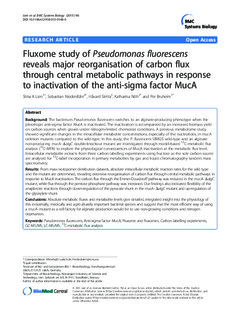Fluxome study of Pseudomonas fluorescens reveals major reorganisation of carbon flux through central metabolic pathways in response to inactivation of the anti-sigma factor MucA
Journal article, Peer reviewed
Permanent lenke
http://hdl.handle.net/11250/283846Utgivelsesdato
2015Metadata
Vis full innførselSamlinger
Sammendrag
Background: The bacterium Pseudomonas fluorescens switches to an alginate-producing phenotype when the
pleiotropic anti-sigma factor MucA is inactivated. The inactivation is accompanied by an increased biomass yield
on carbon sources when grown under nitrogen-limited chemostat conditions. A previous metabolome study
showed significant changes in the intracellular metabolite concentrations, especially of the nucleotides, in mucA
deletion mutants compared to the wild-type. In this study, the P. fluorescens SBW25 wild-type and an alginate
non-producing mucA- ΔalgC double-knockout mutant are investigated through model-based 13C-metabolic flux
analysis (13C-MFA) to explore the physiological consequences of MucA inactivation at the metabolic flux level.
Intracellular metabolite extracts from three carbon labelling experiments using fructose as the sole carbon source
are analysed for 13C-label incorporation in primary metabolites by gas and liquid chromatography tandem mass
spectrometry.
R es u l t s : From mass isotopomer distribution datasets, absolute intracellular metabolic reaction rates for the wild type
and the mutant are determined, revealing extensive reorganisation of carbon flux through central metabolic pathways in
response to MucA inactivation. The carbon flux through the Entner-Doudoroff pathway was reduced in the mucA- ΔalgC
mutant, while flux through the pentose phosphate pathway was increased. Our findings also indicated flexibility of the
anaplerotic reactions through down-regulation of the pyruvate shunt in the mucA- ΔalgC mutant and up-regulation of
the glyoxylate shunt.
Conclusions: Absolute metabolic fluxes and metabolite levels give detailed, integrated insight into the physiology of
this industrially, medically and agriculturally important bacterial species and suggest that the most efficient way of using
a mucA- mutant as a cell factory for alginate production would be to use non-growing conditions and nitrogen
deprivation.
Keywords: Pseudomonas fluorescens, Anti-sigma factor MucA, Fluxome and fluxomics, Carbon labelling experiments,
GC-MS/MS, LC-MS/MS, 13C-metabolic flux analysis
